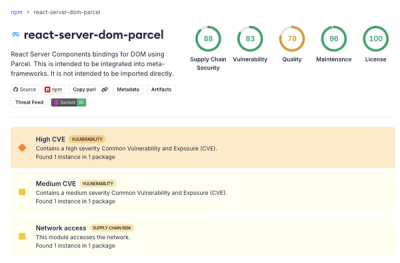
Security News
Deno 2.6 + Socket: Supply Chain Defense In Your CLI
Deno 2.6 introduces deno audit with a new --socket flag that plugs directly into Socket to bring supply chain security checks into the Deno CLI.
graphql-relay
Advanced tools
This is a library to allow the easy creation of Relay-compliant servers using the GraphQL.js reference implementation of a GraphQL server.
A basic understanding of GraphQL and of the GraphQL.js implementation is needed to provide context for this library.
An overview of GraphQL in general is available in the README for the Specification for GraphQL.
This library is designed to work with the GraphQL.js reference implementation of a GraphQL server.
An overview of the functionality that a Relay-compliant GraphQL server should provide is in the GraphQL Relay Specification on the Relay website. That overview describes a simple set of examples that exist as tests in this repository. A good way to get started with this repository is to walk through that documentation and the corresponding tests in this library together.
Install Relay Library for GraphQL.js
npm install graphql graphql-relay
When building a schema for GraphQL.js, the provided library functions can be used to simplify the creation of Relay patterns.
Helper functions are provided for both building the GraphQL types for connections and for implementing the resolve method for fields returning those types.
connectionArgs returns the arguments that fields should provide when they return a connection type that supports bidirectional pagination.forwardConnectionArgs returns the arguments that fields should provide when they return a connection type that only supports forward pagination.backwardConnectionArgs returns the arguments that fields should provide when they return a connection type that only supports backward pagination.connectionDefinitions returns a connectionType and its associated edgeType, given a node type.connectionFromArray is a helper method that takes an array and the arguments from connectionArgs, does pagination and filtering, and returns an object in the shape expected by a connectionType's resolve function.connectionFromPromisedArray is similar to connectionFromArray, but it takes a promise that resolves to an array, and returns a promise that resolves to the expected shape by connectionType.cursorForObjectInConnection is a helper method that takes an array and a member object, and returns a cursor for use in the mutation payload.offsetToCursor takes the index of a member object in an array and returns an opaque cursor for use in the mutation payload.cursorToOffset takes an opaque cursor (created with offsetToCursor) and returns the corresponding array index.An example usage of these methods from the test schema:
var { connectionType: ShipConnection } = connectionDefinitions({
nodeType: shipType,
});
var factionType = new GraphQLObjectType({
name: 'Faction',
fields: () => ({
ships: {
type: ShipConnection,
args: connectionArgs,
resolve: (faction, args) =>
connectionFromArray(
faction.ships.map((id) => data.Ship[id]),
args,
),
},
}),
});
This shows adding a ships field to the Faction object that is a connection. It uses connectionDefinitions({nodeType: shipType}) to create the connection type, adds connectionArgs as arguments on this function, and then implements the resolve function by passing the array of ships and the arguments to connectionFromArray.
Helper functions are provided for both building the GraphQL types for nodes and for implementing global IDs around local IDs.
nodeDefinitions returns the Node interface that objects can implement, and returns the node root field to include on the query type. To implement this, it takes a function to resolve an ID to an object, and to determine the type of a given object.toGlobalId takes a type name and an ID specific to that type name, and returns a "global ID" that is unique among all types.fromGlobalId takes the "global ID" created by toGlobalID, and returns the type name and ID used to create it.globalIdField creates the configuration for an id field on a node.pluralIdentifyingRootField creates a field that accepts a list of non-ID identifiers (like a username) and maps them to their corresponding objects.An example usage of these methods from the test schema:
var { nodeInterface, nodeField } = nodeDefinitions(
(globalId) => {
var { type, id } = fromGlobalId(globalId);
return data[type][id];
},
(obj) => {
return obj.ships ? factionType : shipType;
},
);
var factionType = new GraphQLObjectType({
name: 'Faction',
fields: () => ({
id: globalIdField(),
}),
interfaces: [nodeInterface],
});
var queryType = new GraphQLObjectType({
name: 'Query',
fields: () => ({
node: nodeField,
}),
});
This uses nodeDefinitions to construct the Node interface and the node field; it uses fromGlobalId to resolve the IDs passed in the implementation of the function mapping ID to object. It then uses the globalIdField method to create the id field on Faction, which also ensures implements the nodeInterface. Finally, it adds the node field to the query type, using the nodeField returned by nodeDefinitions.
A helper function is provided for building mutations with single inputs and client mutation IDs.
mutationWithClientMutationId takes a name, input fields, output fields, and a mutation method to map from the input fields to the output fields, performing the mutation along the way. It then creates and returns a field configuration that can be used as a top-level field on the mutation type.An example usage of these methods from the test schema:
var shipMutation = mutationWithClientMutationId({
name: 'IntroduceShip',
inputFields: {
shipName: {
type: new GraphQLNonNull(GraphQLString),
},
factionId: {
type: new GraphQLNonNull(GraphQLID),
},
},
outputFields: {
ship: {
type: shipType,
resolve: (payload) => data['Ship'][payload.shipId],
},
faction: {
type: factionType,
resolve: (payload) => data['Faction'][payload.factionId],
},
},
mutateAndGetPayload: ({ shipName, factionId }) => {
var newShip = {
id: getNewShipId(),
name: shipName,
};
data.Ship[newShip.id] = newShip;
data.Faction[factionId].ships.push(newShip.id);
return {
shipId: newShip.id,
factionId: factionId,
};
},
});
var mutationType = new GraphQLObjectType({
name: 'Mutation',
fields: () => ({
introduceShip: shipMutation,
}),
});
This code creates a mutation named IntroduceShip, which takes a faction ID and a ship name as input. It outputs the Faction and the Ship in question. mutateAndGetPayload then gets an object with a property for each input field, performs the mutation by constructing the new ship, then returns an object that will be resolved by the output fields.
Our mutation type then creates the introduceShip field using the return value of mutationWithClientMutationId.
After cloning this repo, ensure dependencies are installed by running:
npm install
This library is written in ES6 and uses Babel for ES5 transpilation and TypeScript for type safety. Widely consumable JavaScript can be produced by running:
npm run build
Once npm run build has run, you may import or require() directly from node.
After developing, the full test suite can be evaluated by running:
npm test
We actively welcome pull requests. Learn how to contribute.
This repository is managed by EasyCLA. Project participants must sign the free (GraphQL Specification Membership agreement before making a contribution. You only need to do this one time, and it can be signed by individual contributors or their employers.
To initiate the signature process please open a PR against this repo. The EasyCLA bot will block the merge if we still need a membership agreement from you.
You can find detailed information here. If you have issues, please email operations@graphql.org.
If your company benefits from GraphQL and you would like to provide essential financial support for the systems and people that power our community, please also consider membership in the GraphQL Foundation.
Changes are tracked as GitHub releases.
graphql-relay-js is MIT licensed.
FAQs
A library to help construct a graphql-js server supporting react-relay.
The npm package graphql-relay receives a total of 170,436 weekly downloads. As such, graphql-relay popularity was classified as popular.
We found that graphql-relay demonstrated a not healthy version release cadence and project activity because the last version was released a year ago. It has 8 open source maintainers collaborating on the project.
Did you know?

Socket for GitHub automatically highlights issues in each pull request and monitors the health of all your open source dependencies. Discover the contents of your packages and block harmful activity before you install or update your dependencies.

Security News
Deno 2.6 introduces deno audit with a new --socket flag that plugs directly into Socket to bring supply chain security checks into the Deno CLI.

Security News
New DoS and source code exposure bugs in React Server Components and Next.js: what’s affected and how to update safely.

Security News
Socket CEO Feross Aboukhadijeh joins Software Engineering Daily to discuss modern software supply chain attacks and rising AI-driven security risks.